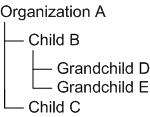Organization structure¶
Organizations follow a hierarchical structure. Each organization may be divided in sub-organizations, while each sub-organization can be divided in further sub-organizations, forming a tree-like structure.
In the following figure, a single organization ("Organization A") can be divided in two sub-organizations: "Child B" and "Child C". Sub-organization "Child B" can be further divided in two other sub-organizations: "Grandchild D" and "Grandchild E". "Organization A" may be referred to as "root" organization, as it is the top-level organization (not a sub-organization of other organization). We define child of an organization every direct division of it to a sub-organization. Thus, "Child B" and "Child C" are children of "Organization A", while "Grandchild D" and "Grandchild E" are children of "Child B". In the same way, we define as parent organization the organization in which a sub-organization belongs. Thus, parent of "Child B" is "Organization A", while parent of "Grandchild D" is "Child B".
